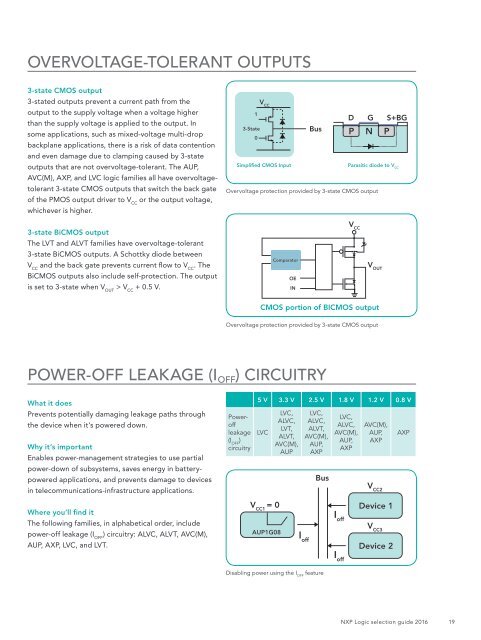Logic selection guide 2016
1Sk34oD
1Sk34oD
Create successful ePaper yourself
Turn your PDF publications into a flip-book with our unique Google optimized e-Paper software.
OVERVOLTAGE-TOLERANT OUTPUTS<br />
3-state CMOS output<br />
3-stated outputs prevent a current path from the<br />
output to the supply voltage when a voltage higher<br />
than the supply voltage is applied to the output. In<br />
some applications, such as mixed-voltage multi-drop<br />
backplane applications, there is a risk of data contention<br />
and even damage due to clamping caused by 3-state<br />
outputs that are not overvoltage-tolerant. The AUP,<br />
AVC(M), AXP, and LVC logic families all have overvoltagetolerant<br />
3-state CMOS outputs that switch the back gate<br />
of the PMOS output driver to V CC<br />
or the output voltage,<br />
whichever is higher.<br />
V CC<br />
1<br />
3-State<br />
0<br />
Simplified CMOS Input<br />
Bus<br />
D G S+BG<br />
P N P<br />
Parasitic diode to V CC<br />
Overvoltage protection provided by 3-state CMOS output<br />
3-state BiCMOS output<br />
V CC<br />
The LVT and ALVT families have overvoltage-tolerant<br />
3-state BiCMOS outputs. A Schottky diode between<br />
V CC<br />
and the back gate prevents current flow to V CC<br />
. The<br />
Comparator<br />
V OUT<br />
BiCMOS outputs also include self-protection. The output<br />
is set to 3-state when V OUT<br />
> V CC<br />
+ 0.5 V.<br />
OE<br />
IN<br />
CMOS portion of BICMOS output<br />
Overvoltage protection provided by 3-state CMOS output<br />
POWER-OFF LEAKAGE (I OFF ) CIRCUITRY<br />
What it does<br />
Prevents potentially damaging leakage paths through<br />
the device when it’s powered down.<br />
Why it’s important<br />
Enables power-management strategies to use partial<br />
power-down of subsystems, saves energy in batterypowered<br />
applications, and prevents damage to devices<br />
in telecommunications-infrastructure applications.<br />
Poweroff<br />
leakage<br />
(I OFF<br />
)<br />
circuitry<br />
5 V 3.3 V 2.5 V 1.8 V 1.2 V 0.8 V<br />
LVC<br />
LVC,<br />
ALVC,<br />
LVT,<br />
ALVT,<br />
AVC(M),<br />
AUP<br />
LVC,<br />
ALVC,<br />
ALVT,<br />
AVC(M),<br />
AUP,<br />
AXP<br />
Bus<br />
LVC,<br />
ALVC,<br />
AVC(M),<br />
AUP,<br />
AXP<br />
AVC(M),<br />
AUP,<br />
AXP<br />
V CC2<br />
AXP<br />
Where you’ll find it<br />
The following families, in alphabetical order, include<br />
power-off leakage (I OFF<br />
) circuitry: ALVC, ALVT, AVC(M),<br />
AUP, AXP, LVC, and LVT.<br />
V CC1<br />
= 0<br />
AUP1G08<br />
I off<br />
Device 1<br />
I off<br />
V CC3<br />
I off<br />
Device 2<br />
Disabling power using the I OFF<br />
feature<br />
NXP <strong>Logic</strong> <strong>selection</strong> <strong>guide</strong> <strong>2016</strong><br />
19


